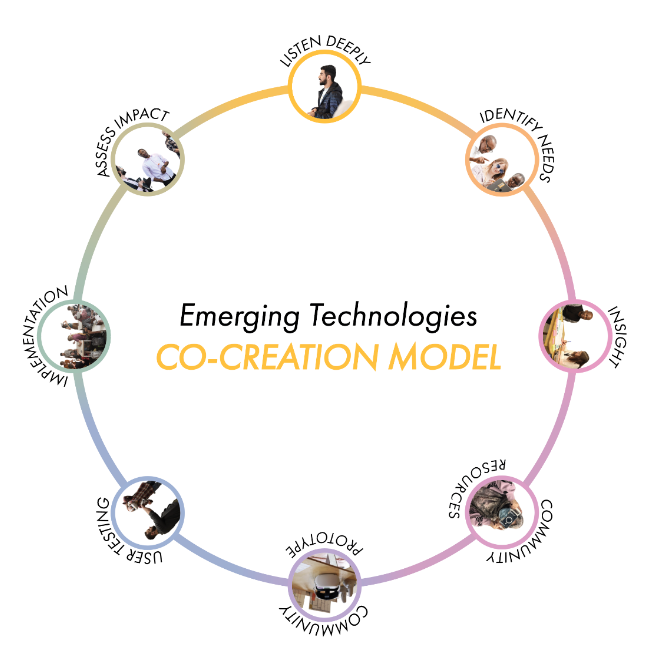Switchboard’s Emerging Technology team provides training and technical assistance (TTA) on the integration of emerging technologies into resettlement programming, with a current focus on virtual reality (VR). Co-creation is at the heart of this exciting new TTA area. This blog post describes how service providers can use design thinking and the co-creative process through technology to address ongoing and emerging barriers to newcomers’ self-sufficiency and integration.
Co-creation, Defined
Co-creation is a method that puts newcomer clients at the center of the design process. It enables more innovative products and well-designed programs that do not have a single “owner.” Benefits of co-creation include greater insight into the needs of specific newcomer populations, including newly arrived refugees; greater success in accommodating newcomers’ needs from the outset; and mutually supportive integrations of content and technology.
Examples of Co-created Resettlement Resources:
- IDEO and National Resource Center for Refugees, Immigrants, and Migrants (NRC-RIM) health education campaigns:
- No Judgement
- Honest Conversations
- Mothers x Mothers (learn more about the process of developing Mothers x Mothers here!)
- International Rescue Committee (IRC) in Salt Lake City, UT 360° videos:
- IRC in Missoula, MT 360° video: Enjoying a Local Tea Shop
The co-creative process described in this post has been informed by field research from IRC Salt Lake City, conducted by former refugees hired as paid research affiliates, as well as by University of Utah design students working within an academic setting. See Switchboard’s Getting Started with Virtual Reality Toolkit to learn more!
Eight Co-creation Design Stages
These stages of the co-creation design process are a guide to help service providers bring ideas to life with the communities they serve. These stages are not static. Throughout the process of learning from community members and gathering insights about problems and barriers, many of the stages will repeat.
The co-creation process always starts with listening with empathy. The insights gleaned from that listening will help providers generate new ideas and determine which ideas are worth moving forward to prototype. Next, providers and community members can begin refining the idea through an iterative process—revising and re-prototyping the idea until there is a workable, physical prototype ready to test for community feedback. From there, this iterative cycle continues until, in consultation with the community, providers arrive at a viable final product.

Imagine a fictional nonprofit organization, Welcome Home, is working with refugee newcomers in a local community. Welcome Home recognizes the need for a central community hub, such as a community center, where newcomers can access various services, participate in cultural activities, receive counseling, and engage in community-building initiatives. Welcome Home decides to use a co-creative process to develop this hub. Follow along in the blue boxes to see how they apply each stage of co-creation!
- Listen Deeply
- Create opportunities to learn from the community.
- Conduct listening sessions and solicit observations with genuine curiosity and empathy.
Welcome Home starts by conducting extensive interviews and focus group discussions with newcomers to understand their needs, aspirations, and preferences regarding the community center. This involves collaborating closely with refugee community leaders, social workers, and local stakeholders. These listening sessions can solicit the groups’ personal ambitions and community issues through questions or prompts. In this scenario, it is important for facilitators to just listen, digest, and hold space for engagement—no solutions are urgently necessary at this stage.
- Identify Contextual Needs
- Complete a comprehensive assessment to address a problem area within a specific resettlement program or context, which calls for a fresh perspective—also referred to as a “good problem.” Consider community observations and the specific context to craft questions and frames at the macro-scale.
- Listen to community voices on the matter by attending relevant programming or otherwise engaging with the community.
- This is the stage that reveals the deeper needs and desires of the community. It is a step to take on with the community, not simply for them.
Welcome Home looks for patterns and trends in how community members articulate their needs. This might involve a formalized needs assessment or in-person brainstorming sessions with stakeholders using diagramming or taking notes. The goal is to learn from the group while remaining open-minded about how things may adapt and evolve later in the process. Everyone should feel welcome to contribute. This stage also creates an opportunity for Welcome Home to build connections and trust within the community.
Example of Comprehensive Assessment:
- Switchboard: Community Needs Assessment with Newcomers
- Formulate Insights
- Synthesize already-known community needs based on lived experience.
- Gather specific information, findings, and themes from others’ experiences and distill them down into a few key insights.
- Share these insights with others for feedback and buy-in, to help fuel the next stage.
Based on the insights gathered, Welcome Home facilitates ideation sessions involving both newcomers and other key stakeholders—and, if possible, other community professionals, such as designers. Together, they brainstorm ideas, sketch layouts, and envision the features and amenities of the community hub. To move community discussions from divergent thinking into convergent thinking, they look for common themes and ask probing questions, such as: “Could you walk us through your process for selecting this idea?” Next, they collectively decide on the top ideas to move forward by voting, clustering, and/or discussing. This, too, ought to be undertaken with community collaborators. The most innovative insights come from a diverse group of lived experiences solicited at workshops, community events, etc.
- Connect Community to Resources and Tools
- Formalize the co-creation community and provide key information and guidance to support engagement.
- Connect the co-creation community to resources such as human power, tools, and partnership.
Welcome Home works with the community to establish the key co-creation group and pulls in resources. Resources might include consumer or emerging technology from local libraries to be used at the community hub. Another model could be establishing internship or volunteer opportunities with stipends from the local university to support the development of the community hub. Connecting resources to the community will look different depending on the context. Throughout the process, Welcome Home keeps the emphasis on collaborative decision-making, empowering the community to take ownership of the project. It is essential that the community have a voice in shaping the resources and expected outcomes.
Resource for Community Design:
- Develop Community Prototypes Together
- Develop a prototype that highlights what the final product will “work like” or “look like.”
- Note: this is the first iterative output in response to learning with the community, which is crucial to advance a collective vision for a functioning product.
Welcome Home and the community create a prototype of the community hub to share with others for feedback. This prototype could involve diagrams, images, 3D models, or videos that depict the new community hub. In this stage, there are continuous feedback loops where the key contributors from relevant communities provide input on proposed designs and concepts. This helps ensure that the community hub reflects newcomers’ cultural values and addresses concerns or preferences they may have. For example, feedback could lead Welcome Home to integrate spaces for prayer, cultural performances, or traditional ceremonies.
Resource for Prototyping:
- Invision: Prototyping and Play
- Conduct Public User Testing
- Deploy community prototypes in an expanded pool of community members.
- Refine physical or digital products through public user feedback, testing whether the “good problem” has been sufficiently addressed.
Welcome Home now gathers feedback from a larger pool of contributors on the proposed community hub designs and concepts. This could involve formal and informal focus groups with friends, partners, and neighbors to test prototypes. These groups should, if possible, contain people who are familiar with the co-creation process alongside those who may not be. Both perspectives are important. Welcome Home will incorporate their feedback into further refinement of the idea through multiple rounds of ideation and prototyping with the community.
- Implement the Project
- Introduce the product to the public to see if the “good problem” has been thoroughly addressed.
- Gather feedback on the larger community’s experience interfacing with the product.
Welcome Home is ready to launch the community hub! For a physical space, local contractors may be hired, and community members might volunteer to contribute to the construction process, fostering a sense of ownership and pride in the project. Once complete, Welcome Home deploys the product to the public for multi-purpose use and feedback.
- Assess Impact
- Use an intentional, formalized process to analyze the product’s viability.
- Collect relevant data on how the product addresses contextual needs in the community.
- Assess how its co-creation process and outcomes, to date, might inform future research and development.
Welcome Home conducts a formal assessment with those utilizing the community hub to gauge its success. This information can help determine how the co-creation process supported a higher-quality hub for the community. Data can also inform similar initiatives in the future.
Resource for Formal Impact Assessments:
Conclusion
By engaging refugee communities in the design and co-creation process, resettlement service providers will produce more innovative products and better designed programs. Benefits of co-creation include greater insight into needs of a community and greater success in accommodating those needs from the outset.
Want to Learn More?
Check out IDEO. (2022). From idea to action [E-learning course]. IDEO U.









